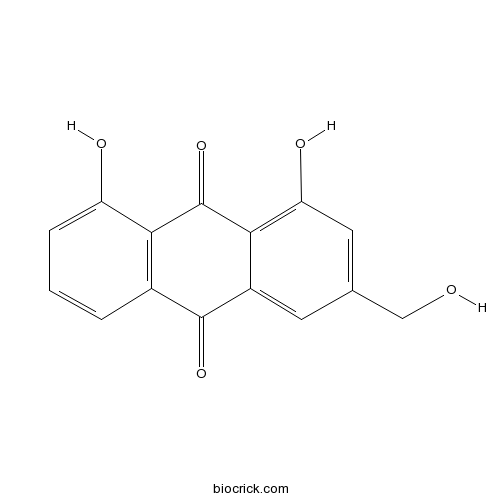A dihydroxyanthraquinone that is chrysazin carrying a hydroxymethyl group at position 3. It has been isolated from plant species of the genus Aloe.
Aloeemodin is able to interact with DNA under certain in vitro conditions, however, in vivo it is negative did not indicate a genotoxic potential, thus, it may be assumed that a genotoxic risk for man might be unlikely.[1]
Aloeemodin has inhibition of β-amyloid aggregation, and has neuroprotective effect on primary hippocampal cells against β-amyloid induced toxicity.[2]
Aloeemodin has anti-fibrotic effects, perhaps through downregulation of the expression of Smad2 mRNA and TGF-β1,TIMP1,and type Ⅰ and Ⅲ collagen proteins,and upregulation of the expression of Smad7 mRNA.[3]
Aloeemodin might have therapeutic effects on liver fibrosis induced by Schistosoma of liver through the effects of TGF-β1,VEGF and FAK expression.[4]
Aloeemodin can suppress the proliferation of HGC-27 cell to induce apoptosis and block cell cycle.[5]
English website: Aloeemodin
Japanese website: Aloeemodin
Chinese website: Aloeemodin
[1] Heidemann A, Völkner W, Mengs U. Mutation Research/fundamental & Molecular Mechanisms of Mutagenesis, 1996, 367(3):123-33.
[2] Ho S L, Poon C Y, Lin C, et al. Current Alzheimer Research, 2015, 12(5):424-33.
[3] Wu Y Y, He S S. World Chinese Journal of Digestology, 2009, 17(27):2778-83.
[4] Dan X U, Zhou W, Hong-Gang Y U. Chinese Journal of Integrated Traditional & Western Medicine on Liver Diseases, 2012, 22(02):107-9.
[5] Nan J, Qin Y X, Liu J, et al. J Modern Oncol, 2008, 16(06):919-21.
[6]Chen C S, Sang X F. Chinese Journal of Health Laboratory Technology, 2011(05):1088-9.



